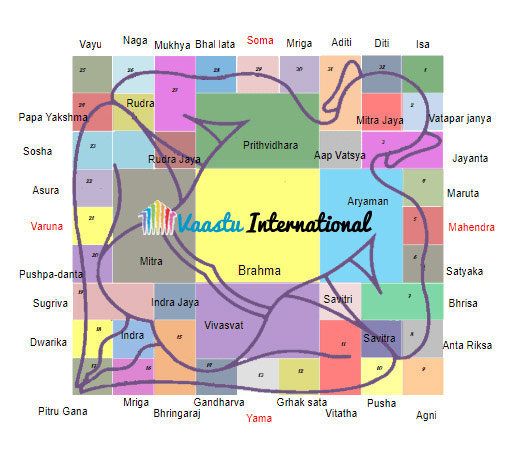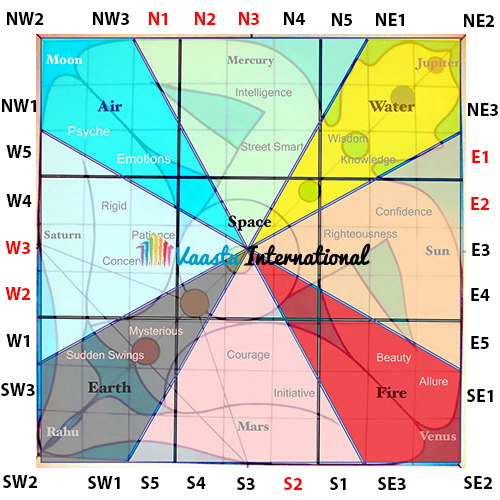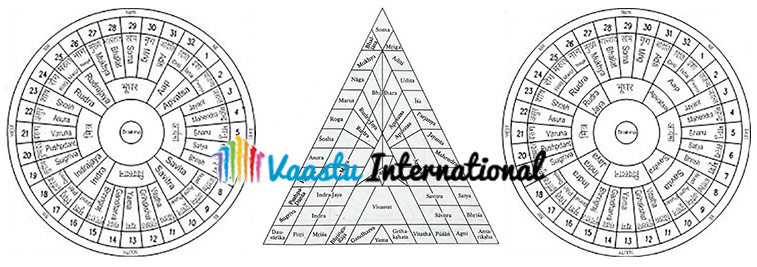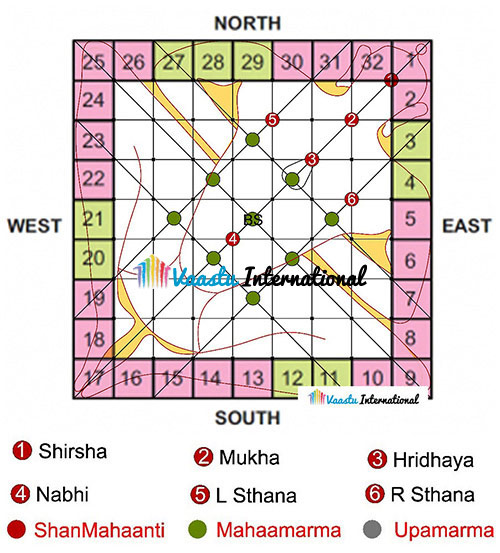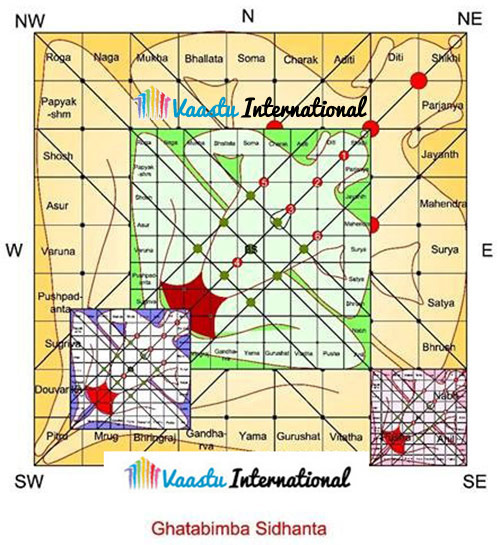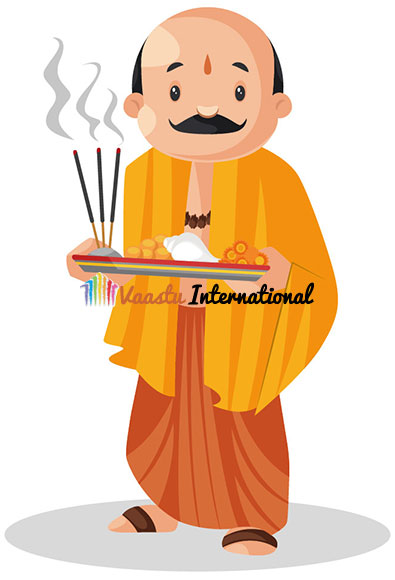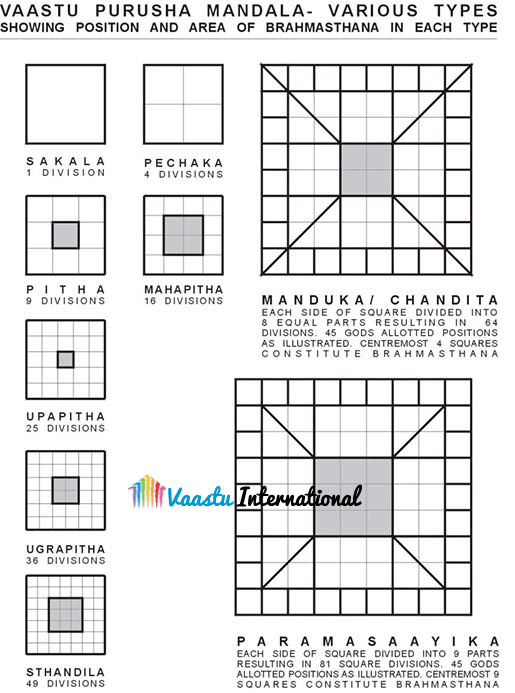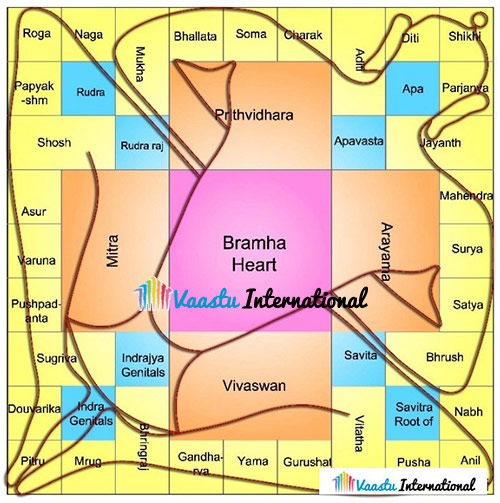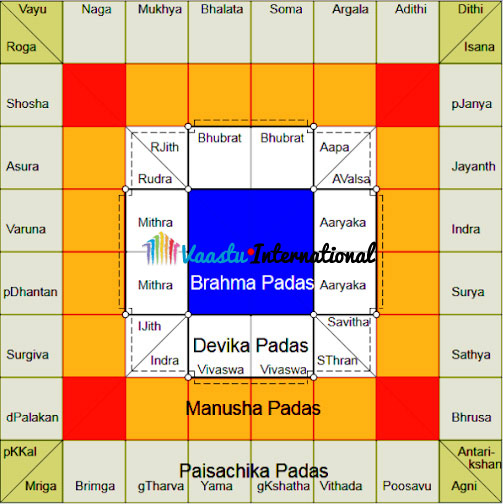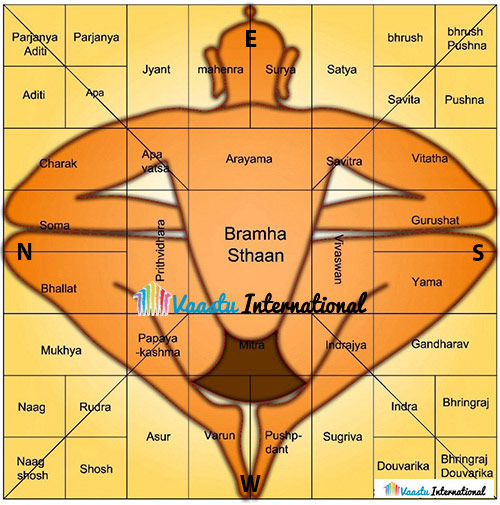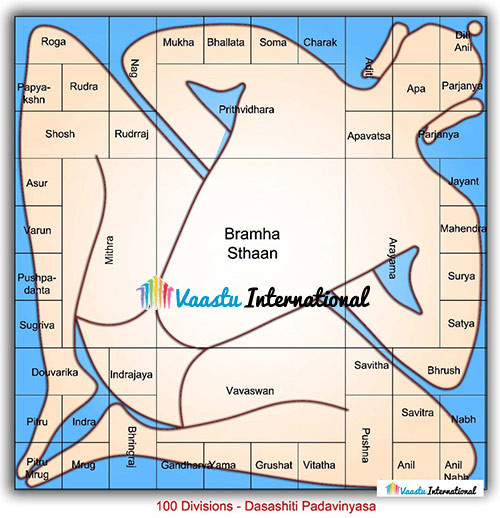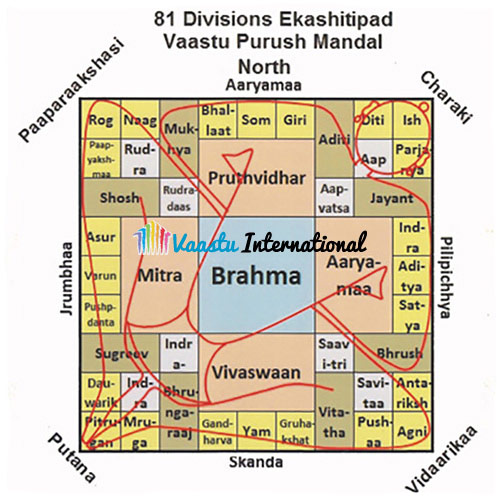VASTU SHASTRA
45 Vastu Devtas (Energy Fields)
Vastu Shastra gives the directive principles regarding construction of buildings so as not to displease the Vastu Purusha. These principles are explained with the help of the diagram called the Vastu Purusha Mandala.
TO KNOW MORE ABOUT 45 VASTU DEVTAS [ENERGY FIELDS] - CLICK ON BUTTONS
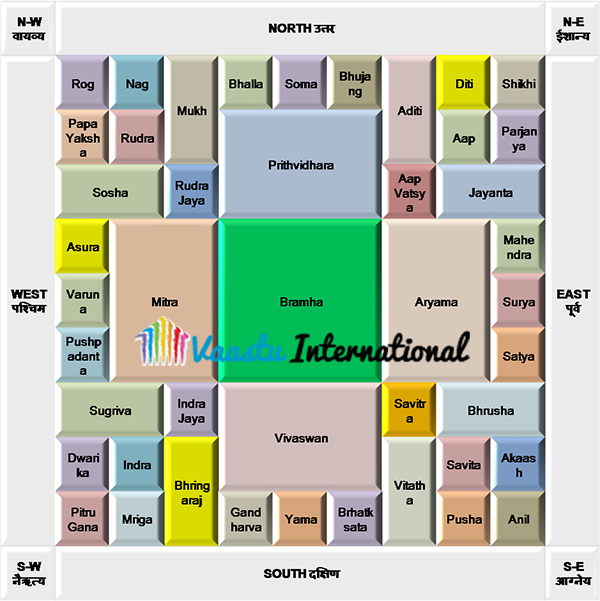
FOR VAASTU INTERNATIONAL COURSES - CLICK HERE
FOR VASTU NUMEROLOGY COURSES - CLICK HERE
45 GODS in VASTU PURUSHA MANDAL :
-
The diagrams shown below, known as Vastu Purusha Mandala, is a metaphysical square plan that illustrates how the Vastu Purusha was pinned down by Brahma and 44 Gods - face down, with his head to the North-East and his feet towards the South-West.
-
The diagram is divided into 9 x 9 = 81 parts. The positions of the 45 gods (32 in the external enclosures and 13 in the internal enclosures) who are holding down the Vastu Purusha are shown. These symbolic Gods rule various aspects of life and have certain inherent qualities.
-
The function of the rooms placed in each area of the house was according to the nature of the deity ruling that particular area.
According to Vastu Shastra, if the house is designed as per the Vastu Purusha Mandala, a perfectly balanced environment which ensures enhanced health, wealth and happiness is created, because the ancient Vaastu pundits figured out that when the different rooms were placed according to the Vastu Mandala, good disposition to the Sun, proper ventilation and lighting and privacy would be ensured.
One should propitiate these deities and chalk out the building plan, entrances and doors according to the Vaastu Mandala.
(Always Remember that Circular and Triangular Vastu Purush Mandalas, Given in Our Ancient Texts, are for Circular and Triangular Structures / Planning only. Join our Advance Vastu Practitioner Course.)
1. Ish / Shikhi (NE2) - The first place is occupied by Lord Shikhi and a main entry here denotes sorrow, loss and fear from fire.
2. Parjanya (NE3) - The second place is occupied by Lord Parjanya. Placing a door here will certainly invite grief and poverty.
3. Jayant (E1) - The third place is occupied by Lord Jayant. Doors in this place mean that the occupants will be blessed with money.
4. Mahendra / Indra (E2) - The fourth place is occupied by Lord Indra. Placing the main door here ensures both respect and fame.
5. Surya (E3) - The fifth place is occupied by Lord Surya. A door here gives both power and money.
6. Satya (E4) - The sixth place is occupied by Lord Satya. A door in this place means both loss and theft.
7. Bhrusha (E5) - The seventh place is occupied by Lord Brish. Placing a door here creates both anger and cruelty.
8. Akash (SE1) - The eighth place is occupied by Lord Akash/Antariksha. A door in this place will invite theft and loss from fire.
9. Anil (SE2) - The ninth place is occupied by Lord Anil, and placing a door here will lead to health problems for the inmates.
10. Pusha (SE3) - The tenth place is occupied by Lord Pusha. A door here will give the occupant a bad name in society.
11. Vitatha (S1) - The eleventh place is occupied by Lord Vitatha, and a door here will cause fear and depression
12. Gruhakshata (S2) - The twelfth place is occupied by Lord Brithttakst. A door in this place gives good children and prosperity.
13. Yama (S3) - The thirteenth place is occupied by Lord Yama, and a door in this place gives monetary gains.
14. Ghandharva (S4) - The fourteenth place is occupied by Lord Gandharva and placing a door in this place makes the occupants fearless.
15. Bhringraj (S5) - The fifteenth place is occupied by Lord Bhringraj. A door here will cause both poverty and diseases.
16. Mrig (SW1) - The sixteenth place is occupied by Lord Mrig. Doors in this place denote poverty and diseases as well.
17. Pitra (SW2) - The seventeenth place is occupied by Lord Pitra. Placing a door in this region means poverty and enemies.
18. Dauwarik (SW3) - The eighteenth place is occupied by Lord Dowairk. Women will face a variety of problems if a door is put in this area.
19. Sugreeva (W1) - The nineteenth place is occupied by Lord Sugriva, and a door in this place gives prosperity to the owner.
20. Pushpadant (W2) - The twentieth place is occupied by Lord Pushpadant. A door in this place will ensure both monetary gains and a happy and healthy family to the owner.
21. Varun (W3) - The twenty-first place is occupied by Lord Varundev. Doors in this area bring both money and good luck.
22. Asura (W4) - The twenty-second place is occupied by Lord Asur and a door in this place signifies bad luck.
23. Shosha (W5) - The twenty-third place is occupied by Lord Shosh. A door here is sure to bring unimaginable loss and bad luck.
24. Paapyakshma (NW1) - The twenty-fourth place is owned by Lord Paapyakshama. Diseases and grief will come to the occupants if a door is placed here.
25. Rog (NW2) - The twenty-fifth place is owned by Lord Rog. Doors in this region will cause problems that are tantamount to death and poverty.
26. Nag (NW3) - The twenty-sixth place is owned by Lord Nag. Enemies, disrespect and bad luck will fall on the occupants if a door is put here.
27. Mukhya (N1) - The twenty-seventh place is owned by Lord Mukhya. The occupants will gain spiritual growth, male child and money if a door is placed here.
28. Bhallat (N2) - The twenty-eighth place is occupied by Lord Bhallat. Placing a door in this place ensures both money and abundance. Indeed, this place gives overall abundance.
29. Som (N3) - The twenty-ninth place is occupied by Lord Som. A door in this region gives obedient children, money and prosperity.
30. Bhujang (N4) - The thirtieth place is occupied by Lord Bhujang. Disharmony and quarrels within the family will prevail if doors are placed in this area.
31. Aditi (N5) - The thirty-first place is occupied by Lord Aditi. Occupants will have enemies and face obstructions in life if a door is placed here.
32. Diti (NE1) - The thirty-second place is occupied by Lord Diti. A door here will bring diseases and obstructions.
Marmasthana Sidhanta
Crossing points of longitudinal and latitudinal lines are very sensitive points in Vastu Purush Mandal. They are called as 'Marmasthana, 'Mahamarmsthana and Upmarmsthana.
Mermstahana: - There are sixty four intersection point of two Nadis (Shiras) called Mermasthana.
Mahamermsthana:- There are nine places where 'KonSutra's (3+3=6) intercept each other diagonally called 'MahaMarmasthana'. These intersection points of Raju (vansh) are very sensitive nadis. The remaining crossing points are called as 'UpaMarma'.
Shanmanti : There are six places in Vastu Purush Mandal, known as Shanmahanti. They are as follows : 1) Shir/ Head, 2) Mukha / Mouth, 3)Heart, 4) Nabhi / Navel, 5) Vamsthana / Left Mammal Gland (left side 4-2) and 6) Dakshin sthana/ Right Mammal Gland (right 4-2). They are very sensitive and relate to health problems.
The above mentioned are very sensitive points in Vastupurush mandala and no column or beam should be constructed over it , as it can affects the 'MarmaSthaan' and cause the owner to suffer health problems at that particular limb of his own body.
Ghata-Bimba Sidhanta
The theory of Ghatabimba Drishtaant is very important and it gives us missing links of vastu design.
Parabramha first created the whole shrishti, but his creation would have been baseless. To give base to this, he created eight directions and to support these eight directions he created planets. To preserve these eight directions, he assigned eight parents as a defender called Astapala.
Even though the gradient like colour, heat etc. may vary but the whole world and parts of world, directions and planets guards in uniformity. Hence even in the smallest place the astapala of eight directions and planets never change. For example due to magnetic character, the infra-red rays is reflected more from the South hence Southern side of building is heated more as a natural phenomenon of absorption and reflection of heat And is reflected in Ghata-bimba.
In other words the reflection of the moon that appears in a lake can also be seen in small pot (Ghat). The concept of Vastushastra should also be thought of on the same line. The size of vastupurusha should be proportionate to the size of vastu. e.g. The size of vastupurusha for town is of town size. For village it should be of village size and for residence, residence size. This is called Ghatabimba Drushtanta.
45 CELESTIAL BEINGS (DEVTAS) OF VASTU PURUSH MANDALA
The devotee named as VAASTU PURUSHA, lay down in all the sites. He is surrounded by the celestial beings thus he is called the God of Vaastu . These celestial beings sat on the devotee and laid force on different limbs of the Vastu Purush. The thirty-two celestial beings are seated on the outer limits and 13 beings are seated within inner limits.
A site of any shape can be divided using the VastuPurush Mandala .Each division within the mandala is called pada and an image of the devotee called Vaastu Purusha is drawn in the likeness of man. There is 45 pada in Ekashiti Vastu mandal. Each pada is named after celestial beings.
In accordance with the position occupied in Mandala, by the preceding gods is shown below :-
32 celestial beings (Devtas) seated on the outer limits of the devotee are :-
1) Shikhi / Ish /Agni - Head,
2) Parjanya / Parojaya - Eye,
3) Jayant - Ear,
4) Mahendra / Indra - Neck,
5) Surya - Shoulders,
6) Satya / Sadya - Arm,
7) Bhrush / Bhrisham - Middle Hand,
8) Nabh / Akash - Elbow,
9) Anil / Agni / Vahuhu - Forearm,
10) Pushna / Pusha - Wrist,
11) Vitatha - Side,
12) Gurushat / Kritanta / brhatksata - Side,
13) Yama - Thigh,
14) Gandharva - Knee,
15) Bhringraj / Bhringaraja - Thigh,
16) Mrug / Mriga - Buttock,
17) Pitru / Pitra - Feet,
18) Douvarika / Dwarpal - Buttock,
19) Sugriva - Shank,
20) Pushpadanta - Knee,
21) Varuna / jaladhi-paha - Thigh,
22) Asur / Daitya - Side,
23) Shosh / Sesha - Side,
24) Papyakshma / Yakshma - Wrist,
25) Roga - Forearm,
26) Naga - Elbow,
27) Mukha / Mukhya - Middle Hand,
28) Bhallata - Arm,
29) Soma - Shoulders,
30) Charak / bhujanga / Sarpa - Neck,
31) Aditi - Ear,
32) Diti - Eye.
13 celestial beings (Devtas) seated within inner limits of the devotee are:-
1) Apa / Apaha - Mouth,
2) Apavatsa / Avantsa - Chest,
3) Savitra / Savitraha - Root of Fingers,
4) Savita - Finger Tips,
5) Indra / Vishnu / Indraha - Genitals,
6) Indrajaya / vibhuda - Genitals,
7) Rudra / Rudraha - Root of Fingers,
8) Rudraraj / Rajayakshma - Finger Tips,
9) Arayama / Marichi - Chest,
10) Vivaswan / Vivashvat - Hips,
11) Mitra - Stomach,
12) Prithvidhara / Prthwi - Chest,
13) Brahma - Heart.
Manasara talks about 32 types of VastuPurusha Mandalas / PadaVinyasa, depending upon their applications such as residential buildings, palaces, auditoriums, temples etc. The deities on outer mandala are important as main door entry of building or plot will be there. The inner deities are mostly related to health issues. The zones on mandala are useful for planning the locations of various activities in a house according to elements present in related zone. Any extension or retraction in the plot or construction site, results in imbalance of it, hence Vastu rectification is needed to balance it.
32 Types of Vastu Purush Mandala
Vastu-Pada-Vinyasa is a Square Yantra (Grid) which represents the Ritual Form of Vastu Purusha.
There are 32 types of Vaastu Purusha Mandala ranging from 1 x 1, 2 x 2, 3 x 3 ... to 32 x 32. They are classified under 2 categories, one of Even Numbers (Yugma) and one of Odd Numbers (Ayugma).
The normal position of the Vastu Purusha (head in the northeast, legs in the southwest) but in the Manduka Mandala (8x8) the Vastu Purusha (head facing east and the feet facing west).
An important aspect of the mandala is that when divided into even number of squares, it's center is constituted by a point formed by the intersection of the two perpendicular central lines and are is used for the design of temples whereas when its divided into odd number of squares, it's center is constituted by one module or pada and are used for all other structures.
Vastu Purush Mandala in Site Planning
The mandala is used to plan architecture through a process called the Pada Vinyasa. In this method the site is dived grids/modules or pada. Depending upon the gods occupying the padas, zonal functions of the building is decided. Mandala have certain points known as marma which are vital energy spots on which nothing should be built. They are determined by certain proportional relationships of the squares and the diagonals.
A site of any shape can be divided using the Vastu Purusha Mandalas. Manasara talks about 32 types of Pada Vinyasa, depending upon their applications such as residential buildings, palaces, auditoriums, temples etc.
These 32 types of mandalas with the corresponding names of sites are given below:
A - Used For Fire Altar
1. Sakala Mandala - Eka pada (1 square)
B - Used For Seats
2. Pechaka Mandala - Dwi pada (2 x 2 = 4 squares)
3. Pitha Mandala - Tri pada (3 x 3 = 9 squares)
C - Used For Large Seats
4. Mahapitha Mandala - Chatush pada (4 x 4 = 16 squares)
5. Upapitha Mandala - Pancha pada (5 x 5 = 25 squares)
6. Ugra-pitha Mandala - Shashtha pada (6 x 6 = 36 squares)
D - Used For Mandapas and Prasadas
7. Sthandila Mandala - Sapta pada (7 x 7 = 49 squares)
8. Manduka / Chandita Mandala - Ashta pada (8 x 8 = 64 square) and is said to be "Sukshma" (subtle)
9. Parama-Sayika Mandala - Nava pada (9 x 9 = 81 squares) and is said to be "Sthula" (gross).
10. Aasana Mandala - Dasa pada (10 x 10 = 100 squares)
11. Sthaniya Mandala (11 x 11 = 121 squares)
E - Used For Temple Complexes and Villages
12. Desya Mandala (12 x 12 = 144 squares)
13. Ubhaya-chandita Mandala (13 x 13 = 169 squares)
14. Bhadra Mandala (14 x 14 = 196 squares)
15. Mahasana Mandala (15 x 15 = 225 squares)
16. Padma-Garbha Mandala (16 x 16 = 256 squares)
17. Tri-yuta Mandala (17 x 17 = 289 squares)
18. Karna-Ashtaka Mandala (18 x 18 = 324 squares)
19. Ganita Mandala (19 x 19 = 361 squares)
F - Used For Towns and Cities
20. Surya-Visalaka Mandala (20 x 20 = 400 squares)
21. Susamhita Mandala (21 x 21 = 441 squares)
22. Supratikanta Mandala (22 x 22 = 484 squares)
23. Visalaka Mandala (23 x 23 = 529 squares)
24. Vipra-garbha Mandala (24 x 24 = 576 squares)
25. Vivesa Mandala (25 x 25 = 625 squares)
26. Vipulya-Bhoga Mandala (26 x 26 = 676 squares)
27. Vipra-Kunta Mandala (27 x 27 = 729 squares)
28. Visal-Aksha Mandala (28 x 28 = 784 squares)
29. Vipra-bhakti Mandala (29 x 29 = 841 squares)
30. Visvesvara Mandala (30 x 30 = 900 squares)
31. Isvarakanta Mandala (31 x 31 = 961 squares)
32. Chanrakanta Mandala (32 x 32 = 1024 squares)
In order to understand Vaastu Shastra, it is necessary to understand the Vaastu Purusha Mandala, which is energy grid of square. The Vaastu Purusha Mandala is the basic form in architecture and all other figures are derived from this elementary design.
It provides the method that determines the requirements of architecture in relation to its directions. Each direction is allotted a particular role by the Vaasturatnakara. Every part of the Vaastu Purusha's body is sacred and contains energies that help us in living a contented and peaceful life.
Each work has it's nature and features. Aforesaid knowledge gives us the appropriate direction for a desired work such as where and how to construct a room, outer structure and interior arrangement of rooms according to the nature of work so that we do our work without any problem and handedness.
This knowledge tells us about the nature and work of directions and what kind of work is to be done in which direction. Vaastu knowledge advices what kind of work is best in which directions at where it is medium, normal or average and which direction is prohibited for concerned work.
Vaastu Purusha is present in each and every plot whether it is big or small. It has a fixed and peculiar body. Its head remains hanging down and its body is spread all over the length and breadth of the ground. There is an interesting story in the MATSYA PURANA in which the birth of the Vaastu Purusha is narrated. By reading that story, one knows why the worship of the Vaastu Purusha is necessary before beginning the construction of any house.
While fighting with the demon, Shiva was very much tired and began to sweat profusely. A man was born from the drops of the sweat of Shiva. He looked very cruel. He was very hungry. So he began to make penance to appease Lord Shiva and get a boon from Him.
Shiva was pleased with his penance and appeared before him. The devotee prayed to Shiva, "Oh Lord! Please permit me to eat away all the three worlds." Shiva said, "Let it be so." The joy of that devotee knew no bounds. He got possession on all the three worlds and first he was ready to eat the terrestrial world. Then the celestial beings, Brahma, Shiva and the demons (Rakshasas) also were terrified and caught hold of the devotee encircling him.
Forty-five celestial beings, out of whom 32 from without and 13 from within caught hold of the devotee. The Thirty-two celestial beings are-
(1) ISH (2) PAROJAYA (3) JAYANT (4) INDRA (5) SURYA (6) SADYA (7) BARISHAM (8) AKASH (9) AGNI (10) PUSHNA (11) VITATHA (12) YAMA (13) KRITANTA (14) GANDHARVA (15) BRINGAVAJA (16) MRIGA (17) PITARA (18) DAREPALE (19) SUGRIVA (20) PUSHPADANTA (21) VARUNA (22) DAITYA (23) SESHA (24) YAKSHMA (25) ROGA (26) NAGA (27) MUKHYA (28) BHALLATA (29) SOMA (30) SARPA (31) ADITI and (32) DITI.
All these 32 celestial beings are out of the limits of the devotee whereas the following 13 Beings are within his limits:-
(1) BRAHMA (2) RUDRA (3) INDRAJAYA (4) APAVATSA (5) MARICHI (6) SAVITRI (7) VIVASWAN (8) VISHNU (9) MITRA (10) SAVITA (11) PRITHVIDHARA (12) RUDRA and (13) APA.
These celestial Beings laid force on the different limbs of the devotee and sat on them as shown below:
ISH (AGNI) - head; APA - face; PRITHWI DHARA & ARYAM - Chest; AVANTSA - heart; DITI & INDRA - Shoulders; SURYA & SOMA - Hands; RUDRA & RAJAYAKSHMA - left arm; SAVITRA & SAVITA - right arm; VIVASWAN & MITRA - Stomach; PUSHA & ARYAMA - Wrist; ASUR & SESHA - left side; VITATHA & GRAHAKSHAT - right side; YAMA & VARUNA - Thighs; GANDHARVA & PURAMADAN - on the knees; SUGRIV & BHRISH - shanks; DWARIKA & MRIGA - ankles; JAYA & SHAKRA - on the hairs grown on the feet; BRAHMA - on the heart.
Vastu Shastra describes 45 powers working as Devas and Asuras in a built space. It guides us to keep the 45 powers in perfect balance in our home in order to achieve desired results we need in life.
Vastu Padvinyasa
Vastupadavinysa / Pada Vinyasais a square yantra (Grid), which is used for architectural purpose and represents the ritual form of Vastupurusha.
Navasiti Padvinyasa (81 divisions)
Nava-pada (nine divided site) corresponds to Paramasayika Mandala ( 9 x 9 = 81 squares).
Building for Residential Purpose should be built in the Vaastupurusha Mandala having 81 divisions.
Paramshayin Vaastu consists of eighty-one squares. Forty-five gods, demi-gods and goddesses occupy these eighty-one squares - ranging from single to nine squares. Arrangement of these fourty-five gods and goddesses in Paramshayin diagram is shown in figure above.
Ashtashiti Padvinyasa (64 divisions)
Ashta-pada (eight divided site) corresponds to Manduka / Chandita Mandala (64 square).
According to Mayamatam, outer thirty-two of these gods from Ishaan to Diti (1 to 32), occupy one square (pada) each (forming Paishach Sthan). Eight of the remaining thirteen - Aap, Aapvatsa, Savita, Saavitr, Indra, Jaya, Rudra and Rudrajay - occupy two squares each. The four demi-gods - Aryama, Vivasvaan, Mitra and Bhudhar - occupy six squares each. Brahma (45) occupies the middle nine squares forming Brahamsthan.
Another space arrangement 'Mandook Vaastu' consists of sixty-four squares. Forty-five gods, demi-gods and goddesses occupy these sixty-four squares -ranging from half to four squares. According to Mayamatam, sixteen of these gods, situated in the four corners (1, 2, 9, 10, 17, 18, 25, 26, 33, 34, 36, 37, 39, 40, 42 and 43), occupy half pada each. Eight Gods, situated in the sides of four corners (3, 8, 11, 16, 19, 24, 27 and 32), occupy single pada each. sixteen gods, situated in the outer four cardinal directions (4, 5, 6, 7, 12, 13, 14, 15, 20, 21, 22, 23, 28, 29, 30 and 31), occupy two pada each. The four gods - aryama, Vivasvan, Mitra and Bhudhar (35, 38, 41 and 44) - occupy three squares each. Brahama (45) occupies the middle four squares forming BrahamSthan. Arrangement of these fourty-five gods and goddesses in Mandook diagram Is shown in figure.
The normal position of the Vaastu Purusha - head in North-East and legs in South-West - is as depicted in the Paramasaayika Mandala. However, in the Manduka Mandala, the Vaastu Purusha is depicted with head towards East and feet towards West.
Town or village planning and Raaja Shivir should be planned in the 64 divisions (Chatuhshasthipada) Vaastumandala.
Dasashiti Padvinyasa (100 divisions)
Dasa-pada (ten divided site) corresponds to (100 squares). The ShatPada Vaastupurushamandala is built having (10x10) = 100 divisions. It is used for the construction of mandir, temples, forts , cities, towers for public places.
Huge Buildings, Temples and Marriage Halls should be built in the Vaastupurushamandala having 100 divisions.
Recommendations of other classical texts of vaastu vary to some extent while allotting number of squares to these gods and demi-gods. For the same demi-god(s), different names are also found in different classical texts.
Though familiar with some names like Indra, Surya, Yama, Varuna, Soma, etc., most of the present day readers are completely ignorant of the names of most of these demi-gods. Neither the Vaastu classics nor the modern authors of vaastu books have paid serious thought for deciphering their deep meanings. Glossary of these vaastu gods and goddesses is found in the popular vaastu classic Samaranganasutradhara (14.14-31) under the heading Vaastudevanam Nighantu. Another classical text on vaastu Aparajitaprichchha ( 56.1-17) mainly follows the recommendations of Samaranganasutradhara with minor deviations. Meanings of these forty-five demi-gods have been given in these two classical texts in just one or two words. The same are being given in a tabular form. It has not been found interpretation and application of these demi-gods in any of the available classical texts of vaastu.
Eight Demi-Goddesses
In addition to the above discussed forty-five demi-gods and goddesses, eight malefic beings have been mentioned which rule the directions beyond the boundary of the premises. Their respective directions and probable literal meanings are given in Table. They work as servants to the gods. They do not own any square on the vaastu purush and are born under the demon lineages.
Table : Eight Demi-Goddesses, their Directions and Probable Meanings
Sl No. - Demi- Goddess - Direction Ruled - Probable Meanings
1 - Charaki - North-east - Kind of Venomous Fish
2 - Pilipichchya - East - Inciting Venomous Saliva of a Snake
3 - Vidaarikaa - South-east - Swelling in the Groin
4 - Skanda - South - Causing Destruction
5 - Putana - South-west - Kind of Disease in a Child
6 - Jrumbhaa - West - Opening of the Mouth
7 - Paapaaraakshasi - North-west - Witch, Evil Female Demon
8 - Aaryamaa - North - Milkweed Plant
Vaastumandanam (1.126-127) describes eight outer Bhairavas - Hetuk, Vetaal, Agni, Dwijak, Kaal, Karal, Ekahni and Bhima. These should be worshipped starting with Ishaan. Names of eight bhairavas given in Mantramahodadhi (1.54) are, Asitanga, Ruru-bhairava, Chanda-bhairava or Kaal-bhairava, Krodh-bhairava, Unmatt-bhairava, Kapali-bhairava, Bhishan-bhairava and Samhar-bhairava. Mention of eight demi-goddesses or Bhairvas in the vaastu classics indicate the need to protect the inner constructed space from the surrounding ferocious (asuri or negative) forces, to tame the unruly forces in the neighborhood and to take care of the four corners as well as the four sides outside the premises.
All the possible efforts have been made here to decode the deep meanings of these demi-gods and goddesses. If you refer to the Sanskrit-English dictionary, all the relevant meanings of these seemingly strange words / terms have been given there. Literal meanings of the names of these demi-gods and their classical as well as the possible modern interpretations have also been indicated. Care has been taken to mention only those qualities, characteristics, myths, excerpts, references and stories related to these demi-gods which could directly or indirectly be useful in vaastu.
For example, Shiva ruling the Ishana square is an omniscient Yogi living an ascetic life on Mount Kailash. Thus Ishana is best for running a Yoga and Meditation centre successfully. One can achieve ultimate wisdom here easily, if so inclined. Ishana is best for living an ascetic life. Like Mount Kailash, it is the coldest area in any vaastu. Considering another example, Nirriti literally means "absence of law or lawless or that which is beyond the order". Thus the square of Nirriti can be best utilised for production and selling of liquor, running a brothel, a slaughter house, gobar gas plant in a farm house or an operation theatre in a hospital. This square invites and encourages illegal, immoral, unethical and anti-social activities.
FOR VASTU SHASTRA IN HINDI CLICK HERE
FOR 45 DEVTAS OF VASTU PURUSHA MANDALA IN HINDI CLICK HERE
FOR 16 VASTU ZONES IN HINDI CLICK HERE
FOR FIVE ELEMENTS OF VASTU IN HINDI CLICK HERE
FOR AYADI VASTU IN HINDI CLICK HERE
FOR GEOPATHIC STRESS VASTU IN HINDI CLICK HERE
FOR VASTU AND COSMIC ENERGY IN HINDI CLICK HERE
FOR VASTU TIPS IN HINDI - CLICK HERE
VASTU TIPS FOR PAINTINGS - CLICK HERE
VASTU TIPS FOR CLOCK IN HINDI - CLICK HERE
VASTU TIPS FOR REMOVING NEGATIVE ENERGY IN HINDI - CLICK HERE
VASTU TIPS FOR POSITIVE ENERGY IN HINDI - CLICK HERE
VASTU TIPS FOR CAREER IN HINDI - CLICK HERE
VASTU TIPS FOR MONEY IN HINDI - CLICK HERE
VASTU TIPS FOR HAPPY MARRIED LIFE IN HINDI - CLICK HERE
VASTU TIPS FOR PLOTS IN HINDI - CLICK HERE
FOR VASTU TIPS ON BEDROOM IN HINDI - CLICK HERE
FOR VAASTU MEDITATION - CLICK HERE
FOR AROMA VASTU TIPS - CLICK HERE
FOR CRYSTAL VASTU (RATNADHYAYA) - CLICK HERE
FOR ART OF GIVING - CLICK HERE
FOR VASTU NUMEROLOGY - CLICK HERE
Er. Rameshwar Prasad invites you to the Wonderful World of Vastu Shastra
Engineer Rameshwar Prasad(B.Tech., M.Tech., P.G.D.C.A., P.G.D.M.) Vaastu International
|


